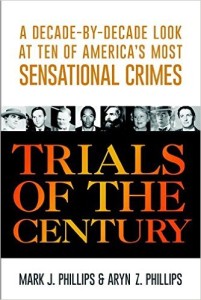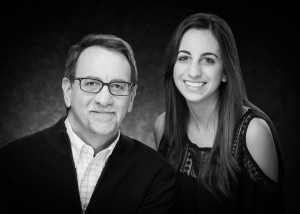 Trials of the Century: A Decade-by-Decade Look at Ten of America’s Most Sensational Crimes
Trials of the Century: A Decade-by-Decade Look at Ten of America’s Most Sensational Crimes
By Mark J. Phillips and Aryn Z. Phillips
Trials of the Century is a study in opposites. Its often-gruesome subject matter is discussed with tact and a simple matter-of-factness; it is scholarly, thoroughly-researched yet wholly accessible; the authors apply a keen legal eye to the evidence and verdicts, while evincing a perceptible compassion for the victims and their families. Those long dead spring vividly to life as their last days and hours are set forth in rich detail, and the circumstances that brought them to the attention of their accused killers are carefully traced, while the legal maneuverings and strategies of the prosecution and defense are first described and then analyzed.
Most of the famous murder trials in American history are here: Fatty Arbuckle, Sam Shepperd, OJ Simpson, Richard Speck, the Lindbergh Baby, Charles Manson, and, in an epilogue, Casey Anthony. The authors delve deeply into source materials, including testimony and oral arguments from the trials, contemporary media accounts, scholarly analyses, autobiographies of the accused and of counsel, and present-day musings on websites and blogs, to present a comprehensive and well-rounded picture of the primary actors and settings of each trial. Photographs, witness testimony, interviews, letters, and other evidence are excerpted or reprinted in full, breathing a sense of life and personality into the proceedings.
Each chapter opens with a description of the changing milieu of American life in the decade at issue. The “careless people” of the Gilded Age, new Hollywood excesses of the 20’s, the “cafe society” of the 40’s, the race riots of the 60’s, the rise in counterculture in the 70’s, the diet craze of the 80’s, and the prevalence of the internet in the early 2000’s introduce their respective chapters, setting the scene for the violent crimes that follow. Key investigators, prosecutors, and witnesses are identified, and the way that the circumstances and personalities of those individuals play into the development of the evidence and of the media furor surrounding the trials is always highlighted.
What might, in the wrong hands, have been dry and dusty detail of the trials themselves becomes downright gripping instead. Pretrial motions, evidentiary hearings, witness testimony — every element of the trial is analyzed. Each side’s legal strategies, and jury strategies, are dissected, along with their relative effectiveness. Occasional post-trial statements by judges, attorneys, and witnesses are included where possible, sometimes with startling results.
The book does not stop at the courthouse steps. A particularly fascinating element is the examination of how the media of the time impacted each trial. Every one of the trials in the book was a media spectacle, covered with breathless anticipation by journalists, with commentary from those either “in the know” or wanting to appear so, and occasional dramatic statements by the participants. The book moves from the impact of print media, to radio, to newsreels, then television, and finally the internet, as a means not only to disseminate information, but also to stir and inflame the public’s passions and prejudices.
Small details enhance the sense of unreality surrounding the trials. The Lindbergh baby trial was described as “conceivably the largest media event ever,” with seven hundred reporters flocking to the courthouse, 168 new telephone lines installed, and an airfield built on the edge of town for the sole purpose of flying film out for newsreel viewing by those who could not attend in person. A similar circus atmosphere, described as a “Roman Holiday,” prevailed during the Shepperd trial. By the time of Richard Speck’s trial in 1966, wary prosecutors took the first steps to protect their chief witness from the media and filed the first successful motion in Illinois to move a criminal trial based on pretrial publicity. During the Manson trial, the media was so immediately and extensively involved in the case that news reporters were the first to find the perpetrators’ discarded bloody clothing.
The American people themselves are an integral part of each story. In scenarios that will not surprise any readers unfortunate enough to have had hearings or trials set in the San Mateo County courthouse during the 2004 trial of Scott Peterson, the public stood in lines for hours, rushed to fill the courtrooms, clamored for updates, and bought and sold macabre themed souvenirs during the trial of Bruno Hauptmann for the death of the Lindbergh baby. Casey Anthony’s trial was described as the “social media trial of the century,” and Nancy Grace saw her viewership skyrocket with her daily recaps of the trial and colorful edicts on the participants. And anyone over the age of ten must remember the media coverage of O.J. Simpson’s low-speed, two-hour chase in the white Ford Bronco, not to mention the artist’s renderings of each day’s trial, faithfully reproduced in the evening news.
Another recurring theme is the way each trial was a product of its times, and the manner in which the defendants served as a handy scapegoat for the public’s distrust of and aversion to social minorities and changing lifestyles. For instance, the authors note that the 1908 trial of Henry K. Thaw put the “way of life” of the Gilded Age elite on trial, and that the three trials of Roscoe “Fatty” Arbuckle in 1921 and 1922 (two deadlocks followed by an acquittal) were widely viewed as indictments of the out-of-control new Hollywood lifestyle. The Manson case exemplified America’s fascination with hippie life and counterculture, while the Simpson trial was fraught with racial politics. Each crime is placed squarely into its epoch, while simultaneously showing the evolution of highly-publicized murder trials through the course of the century.
The authors also touch on how the crimes and their aftermath are later dramatized, such as the Shepperd case serving as the unacknowledged basis of The Fugitive. The Manson case spawned a bestseller for Deputy DA Vincent Bugliosi and award-winning documentaries and miniseries (and a parody appearance on South Park). O.J. Simpson was less successful in marketing his memoirs, and his acting career was decimated, but the trial brought fame to Johnnie Cochran, who was parodied on Seinfeld.
Not all of the accused or their victims were wealthy or well-known prior to their trials, but those who were received special venom from the public at large. The authors note that trial publicity was often inflected with a sense of self-satisfaction, as with those who shrugged off Sharon Tate’s violent murder as the result of her wealthy Hollywood lifestyle: “Live freaky, die freaky.” Despite his acquittal in the death of Virginia Rappe, and an unprecedented written apology from the jury for the “great injustice” that the legal system had inflicted upon him, Fatty Arbuckle was pilloried as a “moral leper,” blacklisted, and surrounded by protesters for the rest of his public life.
“Disgusted and enthralled,” the authors write, “Americans couldn’t turn away.” They were speaking specifically of Casey Anthony’s trial, but as they demonstrate over and over, the same was true for every trial in the book. They conclude, aptly: “The more things change, the more they stay the same.”
![]()
 About the Authors: Mark J. Phillips has been practicing law for thirty-five years with the Law Offices of Goldfarb, Sturman & Averbach in Encino, California. He is also an adjunct professor at the University of West Los Angeles College of Law, where he teaches courses on trusts and estates.
About the Authors: Mark J. Phillips has been practicing law for thirty-five years with the Law Offices of Goldfarb, Sturman & Averbach in Encino, California. He is also an adjunct professor at the University of West Los Angeles College of Law, where he teaches courses on trusts and estates.
Aryn Z. Phillips is a graduate student at the Harvard T. H. Chan School of Public Health, where she is focusing on social and behavioral sciences.
Trials of the Century is available at Amazon.com.
About the Reviewer: Gretchen Birkheimer is a member of the PAABA Board of Directors and was Co-Chair of the Women Lawyers Section from 2012 through 2016. She practices employment law at Pierce & Shearer LLP in Redwood City.